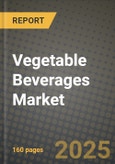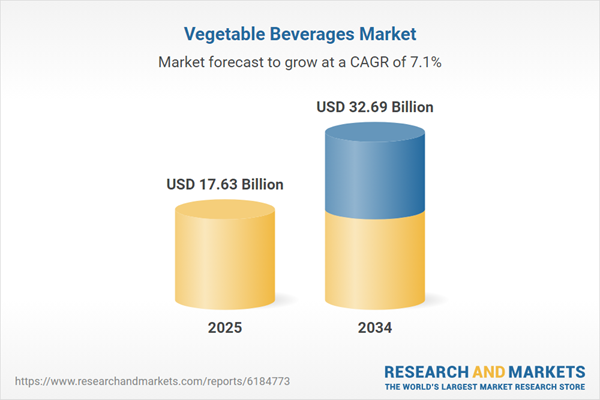Vegetable Beverages Market
The Vegetable Beverages Market encompasses drinkable products derived primarily from vegetables and botanical blends designed for daily hydration, nutrition, and functional wellness. The market spans pure-pressed vegetable juices, cold-pressed blends, shelf-stable ambient packs, chilled HPP lines, fermented options like drinking gazpachos and kraut tonics, and hybrid mixes combining vegetables with fruits, legumes, herbs, and spices for balanced taste and nutrition. Top applications include convenient vegetable intake for busy consumers, low-sugar refreshment, plant-forward meal accompaniment, sports and recovery hydration, digestive comfort, immune support, and culinary pairings for premium dining and on-the-go occasions. Trends emphasize clean labels, reduced sugar versus fruit-dominant juices, salt and acid balance for savory profiles, probiotic or prebiotic enrichment, and culinary innovation featuring regional vegetables and spice signatures. Drivers include rising plant-based adoption, mindful calorie choices, interest in micronutrient density, and demand for transparent sourcing with minimal processing. Competitive dynamics feature established beverage houses, cold-press specialists, dairy and alt-dairy players diversifying into savory drinks, and private labels targeting value and local provenance. Formats range from single-serve PET and glass to aseptic cartons and refillable growlers, with e-commerce subscriptions and foodservice taps extending reach. Success increasingly hinges on taste architecture that moderates vegetal notes, texture control to prevent separation, and thermal or non-thermal processing that preserves color, aroma, and phytonutrients while ensuring safety. Looking ahead, differentiation will pivot on culinary-led flavor systems, functional stacking with botanicals and minerals, regionally sourced ingredients, and packaging that enables ambient stability without compromising freshness cues, positioning vegetable beverages as everyday staples rather than occasional detox choices.Vegetable Beverages Market Key Insights
- Culinary-led flavor design converts trial to habit. Consumers embrace vegetable beverages when chefs’ cues guide balance of acidity, salt, spice, and aromatics to tame bitterness and greenness, with layering techniques and gentle heat or lacto-fermentation rounding flavors for repeatable, meal-friendly drinking experiences across dayparts
- Processing choice defines freshness perception and stability. High-pressure processing preserves color and crisp aromatics yet demands cold chain, while aseptic and gentle thermal steps expand ambient reach but require flavor recalibration and anti-separation strategies such as pectin management and controlled particle size for attractive pour and mouthfeel
- From detox niche to everyday utility. The category is repositioning from occasional cleanses to routine hydration, lunch companions, and post-activity replenishment, with lighter sodium profiles, savory-sweet hybrids, and snackable volumes that integrate seamlessly into work and travel rhythms without flavor fatigue or prep burden
- Function stacking without label noise. Brands add prebiotics, probiotics, electrolytes, and mineral or botanical accents but prioritize concise front-of-pack narratives, aligning benefits like digestive comfort or calm focus with recognizable ingredients and usage cues to avoid overwhelming consumers at shelf or online
- Texture engineering is a loyalty lever. Centrifugation, fine filtration, or controlled pulp retention delivers consistent viscosity, while anti-foaming fill strategies and homogenization profiles ensure clean glass cling and an appetizing sip that survives transport, temperature changes, and time in home refrigerators
- Sourcing stories anchor trust and differentiation. Regional vegetables, seasonal rotations, and transparent farming practices resonate, especially when tied to regenerative outcomes, food-waste valorization using off-spec shapes, and partnerships with local growers that stabilize supply and inspire limited editions
- Portfolio architecture widens reach. Entry-friendly blends with familiar vegetables pave the way to bolder SKUs featuring bitter greens or roots, while culinary collabs create tasting flights and subscriptions that guide consumers along flavor intensity ladders and occasion maps for breakfast, lunch, and evening wind-down
- Channel strategy blends discovery with routine. Foodservice and cafés drive sampling and culinary credibility, retail coolers deliver visibility and impulse, and e-commerce enables bundle curation, education, and subscription cadence tuned to household size and consumption frequency for low-friction replenishment
- Regulatory and QA rigor protect scale. Clear allergen handling, acidification controls, validated shelf-life, and honest front-of-pack descriptors reduce risk and returns, with batch-level traceability and environmental monitoring programs supporting multi-region distribution and retailer standards
- Sustainability signals support premium cues. Lightweight cartons, recycled-content bottles, and reusable formats pair with clean water stewardship and energy-aware processing, while verified claims and practical reuse guidance translate sustainability from abstract promises into observable consumer behaviors at home
Vegetable Beverages Market Reginal Analysis
North America
The North American market demonstrates strong traction driven by health-conscious consumers, widespread adoption of plant-based nutrition, and demand for low-sugar alternatives to fruit juices. Cold-pressed and HPP vegetable beverages dominate premium shelves, while shelf-stable formats target mainstream retail and club stores. Flavor innovation featuring kale, beet, spinach, and celery blends supports category diversification. E-commerce and subscription models strengthen brand-consumer relationships, with clean-label transparency, local sourcing, and sustainability shaping purchase preferences across the U.S. and Canada.Europe
Europe’s vegetable beverage market is anchored in its culinary appreciation for natural ingredients and traditional vegetable soups and broths reimagined as drinkable formats. Health awareness, strict food safety regulations, and preference for organic and locally sourced vegetables drive the market. Germany, the UK, and Nordic countries lead in cold-pressed functional juices, while Mediterranean markets favor savory tomato, carrot, and pepper-based drinks. Sustainability in packaging and emphasis on minimal processing appeal to environmentally conscious European consumers.Asia-Pacific
Asia-Pacific experiences robust growth due to rapid urbanization, busy lifestyles, and increasing acceptance of functional plant-based beverages. Consumers in Japan, China, and South Korea appreciate vegetable-based drinks for digestion and beauty benefits, while Southeast Asia embraces fusion flavors using regional vegetables and tropical ingredients. Shelf-stable packaging supports affordability and wide distribution across modern trade, while digital channels and influencer-driven education promote category awareness. Innovation in local flavors and convenience formats fuels expansion across both emerging and mature economies.Middle East & Africa
In the Middle East & Africa, the market is gaining traction through modern trade expansion, health-focused hospitality, and growing awareness of plant-based hydration. Vegetable beverages positioned for hydration and detox are popular in Gulf Cooperation Council countries, while locally sourced ingredients support community-based manufacturing. Temperature stability, halal compliance, and simple ingredient declarations are crucial success factors. Multinational and regional brands collaborate with distributors to enhance cold-chain reliability and visibility in supermarkets and cafés.South & Central America
South & Central America showcase growing potential, supported by strong agricultural output and increasing consumer awareness of vegetable-based nutrition. Brazil, Mexico, and Chile are key adopters, integrating vegetables such as carrot, beet, and spinach into traditional juice culture. Retailers expand offerings through both chilled and ambient aisles, while juice bars and cafes promote fresh-pressed innovations. Local sourcing and seasonal variety resonate with sustainability-minded consumers, while affordability and flavor familiarity underpin mass-market acceptance.Vegetable Beverages Market Segmentation
By Type
- Carrot Juice
- Tomato Juice
- Cucumber Juice
- Blended Juice
By Sales Channel
- Online
- Offline
Key Market players
Campbell Soup Company (V8), PepsiCo (Tropicana, Naked), Kagome Co., Ltd., Del Monte Foods, Dole plc, Ito En, Pokka Sapporo Food & Beverage, Danone (Alpro, Silk), Califia Farms, Vitasoy International, SunOpta, Bolthouse Farms, Suja Life, Innocent Drinks, Pressed Juicery, The Hain Celestial Group, Evolution Fresh, Lakewood Organic, R.W. Knudsen Family, Eckes-Granini GroupVegetable Beverages Market Analytics
The report employs rigorous tools, including Porter’s Five Forces, value chain mapping, and scenario-based modelling, to assess supply-demand dynamics. Cross-sector influences from parent, derived, and substitute markets are evaluated to identify risks and opportunities. Trade and pricing analytics provide an up-to-date view of international flows, including leading exporters, importers, and regional price trends.Macroeconomic indicators, policy frameworks such as carbon pricing and energy security strategies, and evolving consumer behaviour are considered in forecasting scenarios. Recent deal flows, partnerships, and technology innovations are incorporated to assess their impact on future market performance.
Vegetable Beverages Market Competitive Intelligence
The competitive landscape is mapped through proprietary frameworks, profiling leading companies with details on business models, product portfolios, financial performance, and strategic initiatives. Key developments such as mergers & acquisitions, technology collaborations, investment inflows, and regional expansions are analyzed for their competitive impact. The report also identifies emerging players and innovative startups contributing to market disruption.Regional insights highlight the most promising investment destinations, regulatory landscapes, and evolving partnerships across energy and industrial corridors.
Countries Covered
- North America - Vegetable Beverages market data and outlook to 2034
- United States
- Canada
- Mexico
- Europe - Vegetable Beverages market data and outlook to 2034
- Germany
- United Kingdom
- France
- Italy
- Spain
- BeNeLux
- Russia
- Sweden
- Asia-Pacific - Vegetable Beverages market data and outlook to 2034
- China
- Japan
- India
- South Korea
- Australia
- Indonesia
- Malaysia
- Vietnam
- Middle East and Africa - Vegetable Beverages market data and outlook to 2034
- Saudi Arabia
- South Africa
- Iran
- UAE
- Egypt
- South and Central America - Vegetable Beverages market data and outlook to 2034
- Brazil
- Argentina
- Chile
- Peru
Research Methodology
This study combines primary inputs from industry experts across the Vegetable Beverages value chain with secondary data from associations, government publications, trade databases, and company disclosures. Proprietary modeling techniques, including data triangulation, statistical correlation, and scenario planning, are applied to deliver reliable market sizing and forecasting.Key Questions Addressed
- What is the current and forecast market size of the Vegetable Beverages industry at global, regional, and country levels?
- Which types, applications, and technologies present the highest growth potential?
- How are supply chains adapting to geopolitical and economic shocks?
- What role do policy frameworks, trade flows, and sustainability targets play in shaping demand?
- Who are the leading players, and how are their strategies evolving in the face of global uncertainty?
- Which regional “hotspots” and customer segments will outpace the market, and what go-to-market and partnership models best support entry and expansion?
- Where are the most investable opportunities - across technology roadmaps, sustainability-linked innovation, and M&A - and what is the best segment to invest over the next 3-5 years?
Your Key Takeaways from the Vegetable Beverages Market Report
- Global Vegetable Beverages market size and growth projections (CAGR), 2024-2034
- Impact of Russia-Ukraine, Israel-Palestine, and Hamas conflicts on Vegetable Beverages trade, costs, and supply chains
- Vegetable Beverages market size, share, and outlook across 5 regions and 27 countries, 2023-2034
- Vegetable Beverages market size, CAGR, and market share of key products, applications, and end-user verticals, 2023-2034
- Short- and long-term Vegetable Beverages market trends, drivers, restraints, and opportunities
- Porter’s Five Forces analysis, technological developments, and Vegetable Beverages supply chain analysis
- Vegetable Beverages trade analysis, Vegetable Beverages market price analysis, and Vegetable Beverages supply/demand dynamics
- Profiles of 5 leading companies - overview, key strategies, financials, and products
- Latest Vegetable Beverages market news and developments
Additional Support
With the purchase of this report, you will receive:- An updated PDF report and an MS Excel data workbook containing all market tables and figures for easy analysis.
- 7-day post-sale analyst support for clarifications and in-scope supplementary data, ensuring the deliverable aligns precisely with your requirements.
- Complimentary report update to incorporate the latest available data and the impact of recent market developments.
This product will be delivered within 1-3 business days.
Table of Contents
Companies Mentioned
- Campbell Soup Company (V8)
- PepsiCo (Tropicana Naked)
- Kagome Co. Ltd.
- Del Monte Foods
- Dole PLC
- Ito En
- Pokka Sapporo Food & Beverage
- Danone (Alpro Silk)
- Califia Farms
- Vitasoy International
- SunOpta
- Bolthouse Farms
- Suja Life
- Innocent Drinks
- Pressed Juicery
- The Hain Celestial Group
- Evolution Fresh
- Lakewood Organic
- R.W. Knudsen Family
- Eckes-Granini Group
Table Information
| Report Attribute | Details |
|---|---|
| No. of Pages | 160 |
| Published | November 2025 |
| Forecast Period | 2025 - 2034 |
| Estimated Market Value ( USD | $ 17.63 Billion |
| Forecasted Market Value ( USD | $ 32.69 Billion |
| Compound Annual Growth Rate | 7.1% |
| Regions Covered | Global |
| No. of Companies Mentioned | 20 |









